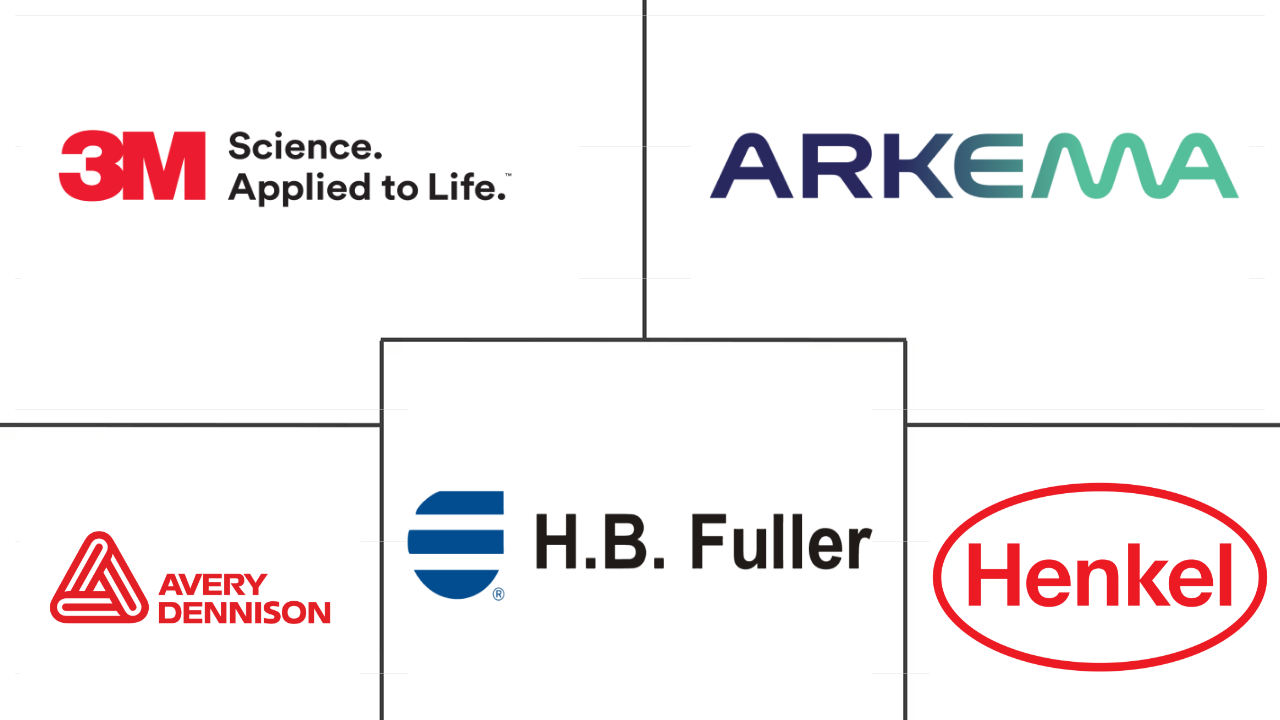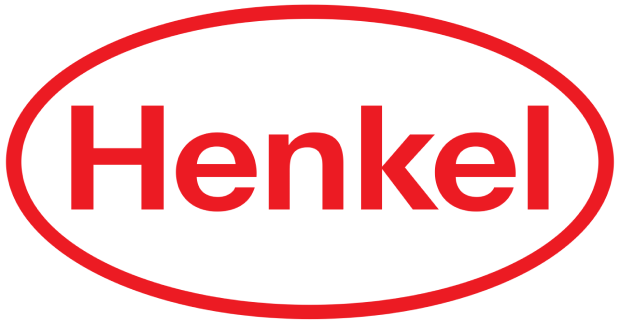Market Size of europe acrylic adhesives Industry
|
|
Study Period | 2017 - 2028 |
|
|
Market Size (2024) | USD 5.54 Billion |
|
|
Market Size (2028) | USD 7.16 Billion |
|
|
Largest Share by End User Industry | Packaging |
|
|
CAGR (2024 - 2028) | 6.60 % |
|
|
Largest Share by Country | Germany |
Major Players |
||

|
||
|
*Disclaimer: Major Players sorted in no particular order |
Europe Acrylic Adhesives Market Analysis
The Europe Acrylic Adhesives Market size is estimated at 5.54 billion USD in 2024, and is expected to reach 7.16 billion USD by 2028, growing at a CAGR of 6.60% during the forecast period (2024-2028).
5.54 Billion
Market Size in 2024 (USD)
7.16 Billion
Market Size in 2028 (USD)
6.19 %
CAGR (2017-2023)
6.60 %
CAGR (2024-2028)
Largest Market by End-user Industry
68.01 %
value share, Packaging, 2023
Packaging is the dominant end-user industry in the market owing to acrylic adhesives widespread usage in pressure-sensitive applications such as labels and tapes.
Largest Market by Technology
86.05 %
value share, Water-borne, 2023
Water-borne is the largest technology type in the market owing to its wide range of applications in the packaging and building and construction industries.
Largest Market by Country
12.49 %
value share, Germany, 2023
In Europe, Germany holds the largest market share owing to the strong presence of manufacturers in the country's packaging and building and construction industries.
Fastest Growing Market by Country
6.72 %
Projected CAGR, Russia, 2024-2028
Due to the increasing demand for packaging solutions, Russia is likely to be the fastest-growing country in the market over the forecast period.
Leading Market Player
8.46 %
market share, Henkel AG & Co. KGaA, 2021

Henkel is the leading acrylic adhesives manufacturer in the region due to the popularity of its products in the packaging industry.
Advancement in material technology to augment the growth of acrylic adhesives
- Acrylic adhesives are widely used in the construction industry because of their applications, such as waterproofing, weather-sealing, cracks sealing, and bonding. The overall revenue of the construction sector in Europe grew tremendously, registering the highest Y-o-Y growth in 2021 compared to 2020 because of the initiatives and measures taken by the EU Commission, such as the infusion of EUR 750 billion for all sectors under the COVID-19 pandemic recovery plan, named Next Generation EU. Under this plan, the construction sector received the highest investment because of the European objective of green and digital transition in buildings, which led to growth in the annual renovation rate of existing buildings and structures. The European construction adhesives segment accounted for about 26% of the global market in 2021.
- Acrylic adhesives are also widely used across the automotive industry because of their applicability to surfaces such as glass, metal, plastic, and painted surfaces, and their features are helpful in the automotive industry, such as extreme weather resistance, durability, and long-lasting. These are used in engines and car gaskets. The recently proposed regulation (Fit for 55) sets objectives of a 55% reduction in CO2 emissions from vehicles and a 50% reduction in CO2 emissions from vans by 2030. (EU, 2021). It also suggests that by 2035, all emissions from vehicles and vans be eliminated. These factors are expected to increase demand for automotive adhesives in the forecast period.
- Acrylic adhesives are used in the healthcare industry for applications such as assembling medical device parts. The increase in healthcare investments across Europe is expected to lead to a rise in their demand in the forecast period 2022-2028.
Europe's Acrylic adhesive demand aided by the growth of industries in major economies
- From 2017 to 2021, the demand generated from Europe ranked second globally. The share of the demand for acrylic adhesives from this region has consistently accounted for 30-31% of the global demand because of the high manufacturing capacity of the automotive, aerospace, building and construction, and other end-user industries in the region. Acrylic adhesives with reactive, water-borne, and solvent-borne technologies generate most of the demand in the region.
- From 2017 to 2019, the demand for adhesives from this region recorded a CAGR of 2.14%. The slow growth in the demand for acrylic adhesives was due to a decline in automotive production, especially the diesel vehicles segment in the region. The demand from these end-user industries declined with a CAGR of 0.08% in volume terms during this period.
- In 2020, the demand from all end-user industries across the region declined due to constraints in operations, labor, raw material, supply chain, and other areas. Among all industries from all the countries in the region, the automotive industry in Germany and France took the worst hit, declining by 22.96% and 35.60%, respectively, in y-o-y volume terms.
- In 2021, the demand for acrylic adhesives started to recover from all countries in the region and was expected to outgrow pre-pandemic demand volume by 2022. The demand from Italy witnessed the highest y-o-y growth of 8.85% in volume terms. This growth trend is expected to continue from 2022 to 2028. The demand for acrylic adhesives from Europe is expected to record a CAGR of 3.80% during the forecast period 2022-2028.
Europe Acrylic Adhesives Industry Segmentation
Aerospace, Automotive, Building and Construction, Footwear and Leather, Healthcare, Packaging are covered as segments by End User Industry. Reactive, Solvent-borne, UV Cured Adhesives, Water-borne are covered as segments by Technology. France, Germany, Italy, Russia, Spain, United Kingdom are covered as segments by Country.
- Acrylic adhesives are widely used in the construction industry because of their applications, such as waterproofing, weather-sealing, cracks sealing, and bonding. The overall revenue of the construction sector in Europe grew tremendously, registering the highest Y-o-Y growth in 2021 compared to 2020 because of the initiatives and measures taken by the EU Commission, such as the infusion of EUR 750 billion for all sectors under the COVID-19 pandemic recovery plan, named Next Generation EU. Under this plan, the construction sector received the highest investment because of the European objective of green and digital transition in buildings, which led to growth in the annual renovation rate of existing buildings and structures. The European construction adhesives segment accounted for about 26% of the global market in 2021.
- Acrylic adhesives are also widely used across the automotive industry because of their applicability to surfaces such as glass, metal, plastic, and painted surfaces, and their features are helpful in the automotive industry, such as extreme weather resistance, durability, and long-lasting. These are used in engines and car gaskets. The recently proposed regulation (Fit for 55) sets objectives of a 55% reduction in CO2 emissions from vehicles and a 50% reduction in CO2 emissions from vans by 2030. (EU, 2021). It also suggests that by 2035, all emissions from vehicles and vans be eliminated. These factors are expected to increase demand for automotive adhesives in the forecast period.
- Acrylic adhesives are used in the healthcare industry for applications such as assembling medical device parts. The increase in healthcare investments across Europe is expected to lead to a rise in their demand in the forecast period 2022-2028.
| End User Industry | |
| Aerospace | |
| Automotive | |
| Building and Construction | |
| Footwear and Leather | |
| Healthcare | |
| Packaging | |
| Other End-user Industries |
| Technology | |
| Reactive | |
| Solvent-borne | |
| UV Cured Adhesives | |
| Water-borne |
| Country | |
| France | |
| Germany | |
| Italy | |
| Russia | |
| Spain | |
| United Kingdom | |
| Rest of Europe |
Europe Acrylic Adhesives Market Size Summary
The Europe Acrylic Adhesives Market is poised for significant growth, driven by its extensive applications across various industries such as construction, automotive, and healthcare. In the construction sector, acrylic adhesives are favored for their properties like waterproofing and weather-sealing, which align with the European Union's initiatives for green and digital transitions in buildings. The construction industry's recovery and expansion, supported by substantial investments from the EU's COVID-19 recovery plan, have bolstered the demand for these adhesives. Similarly, in the automotive sector, the need for durable and weather-resistant adhesives for bonding glass, metal, and plastic surfaces is expected to rise, particularly in light of regulatory pressures to reduce vehicle emissions. The healthcare industry also presents a growing market for acrylic adhesives, driven by increased investments and the need for assembling medical device parts.
The market landscape is characterized by a fragmented structure, with major players like 3M, Arkema Group, AVERY DENNISON CORPORATION, H.B. Fuller Company, and Henkel AG & Co. KGaA holding a significant share. These companies are actively expanding their presence through strategic acquisitions and product innovations, such as H.B. Fuller's acquisition of Fourny NV and Apollo Chemicals, and 3M's introduction of new acrylic adhesive products. The demand for acrylic adhesives in Europe has shown resilience, recovering from the pandemic's impact and expected to continue its upward trajectory. The region's strong manufacturing capacity in automotive, aerospace, and construction sectors, coupled with the growing packaging industry, further supports the market's expansion prospects.
Europe Acrylic Adhesives Market Size - Table of Contents
-
1. MARKET SEGMENTATION (includes market size in Value in USD and Volume, Forecasts up to 2028 and analysis of growth prospects)
-
1.1 End User Industry
-
1.1.1 Aerospace
-
1.1.2 Automotive
-
1.1.3 Building and Construction
-
1.1.4 Footwear and Leather
-
1.1.5 Healthcare
-
1.1.6 Packaging
-
1.1.7 Other End-user Industries
-
-
1.2 Technology
-
1.2.1 Reactive
-
1.2.2 Solvent-borne
-
1.2.3 UV Cured Adhesives
-
1.2.4 Water-borne
-
-
1.3 Country
-
1.3.1 France
-
1.3.2 Germany
-
1.3.3 Italy
-
1.3.4 Russia
-
1.3.5 Spain
-
1.3.6 United Kingdom
-
1.3.7 Rest of Europe
-
-
Europe Acrylic Adhesives Market Size FAQs
How big is the Europe Acrylic Adhesives Market?
The Europe Acrylic Adhesives Market size is expected to reach USD 5.54 billion in 2024 and grow at a CAGR of 6.60% to reach USD 7.16 billion by 2028.
What is the current Europe Acrylic Adhesives Market size?
In 2024, the Europe Acrylic Adhesives Market size is expected to reach USD 5.54 billion.

